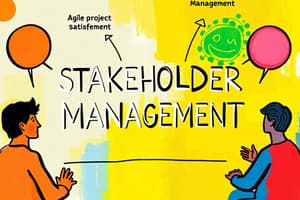Podcast
Questions and Answers
Agile project management emphasizes ______, collaboration, and customer satisfaction
Agile project management emphasizes ______, collaboration, and customer satisfaction
flexibility
Agile methodologies include Scrum, Kanban, and ______
Agile methodologies include Scrum, Kanban, and ______
Lean
Each sprint in Agile project management has a defined duration, usually two to four ______
Each sprint in Agile project management has a defined duration, usually two to four ______
weeks
Adaptive planning in Agile projects involves adjusting the project plan and priorities based on changing requirements and feedback from ______
Adaptive planning in Agile projects involves adjusting the project plan and priorities based on changing requirements and feedback from ______
Waterfall project management is characterized by a linear and sequential approach, with distinct phases such as requirements, design, implementation, testing, and ______
Waterfall project management is characterized by a linear and sequential approach, with distinct phases such as requirements, design, implementation, testing, and ______
Agile methodologies promote ______ between team members and stakeholders
Agile methodologies promote ______ between team members and stakeholders
Agile projects prioritize customer satisfaction by delivering working software or features in each ______
Agile projects prioritize customer satisfaction by delivering working software or features in each ______
Stakeholder management is a project management approach that focuses on identifying, analyzing, and addressing the needs and expectations of ______
Stakeholder management is a project management approach that focuses on identifying, analyzing, and addressing the needs and expectations of ______
The first step in stakeholder management is to identify all ______ involved in the project
The first step in stakeholder management is to identify all ______ involved in the project
Waterfall project management is a linear, sequential approach to project management that follows a predefined plan from start to ______
Waterfall project management is a linear, sequential approach to project management that follows a predefined plan from start to ______
Flashcards are hidden until you start studying
Study Notes
Project Management: Agile, Stakeholder, and Waterfall Approaches
Project management is a crucial discipline that helps organizations plan, execute, and deliver projects on time, within budget, and to the satisfaction of stakeholders. There are several project management methodologies, each with its own strengths and weaknesses. In this article, we will discuss three popular methodologies: Agile, Stakeholder, and Waterfall project management.
Agile Project Management
Agile project management is a methodology that emphasizes flexibility, collaboration, and customer satisfaction. It is particularly useful for projects with rapidly changing requirements and is known for its iterative approach, allowing an incremental delivery of the product. Agile methodologies include Scrum, Kanban, and Lean. Some of the key aspects of Agile project management include:
-
Iterative Development: Agile methodologies break down the project into smaller, manageable units called sprints. Each sprint has a defined duration, usually two to four weeks, during which the team works on a specific set of features or requirements.
-
Adaptive Planning: Agile projects are inherently unpredictable, and requirements may change during the project's lifecycle. Adaptive planning involves adjusting the project plan and priorities based on changing requirements and feedback from stakeholders.
-
Collaboration: Agile methodologies promote collaboration between team members and stakeholders, ensuring that everyone is aligned on project goals and progress.
-
Customer Satisfaction: Agile projects prioritize customer satisfaction by delivering working software or features in each sprint, allowing stakeholders to provide feedback and ensure that the product meets their needs.
Stakeholder Management
Stakeholder management is a project management approach that focuses on identifying, analyzing, and addressing the needs and expectations of stakeholders. Stakeholders can be individuals or groups with a vested interest in the project, such as team members, customers, suppliers, regulators, and the public. Key aspects of stakeholder management include:
-
Identification: The first step in stakeholder management is to identify all stakeholders involved in the project. This can be achieved through various techniques, such as interviews, surveys, and workshops.
-
Analysis: Once all stakeholders have been identified, the next step is to analyze their needs, expectations, and influence on the project. This can be done by assessing their power, interest, and willingness to engage.
-
Engagement: Engaging stakeholders involves communicating with them, providing updates on project progress, and soliciting their feedback. This helps to build trust and ensure that their needs and expectations are being met.
-
Monitoring and Review: Stakeholder management requires continuous monitoring and review to ensure that stakeholders remain engaged and satisfied with the project's progress.
Waterfall Project Management
Waterfall project management is a linear, sequential approach to project management that follows a predefined plan from start to finish. It is characterized by its rigid structure and emphasis on documentation. The Waterfall methodology is typically used in projects with well-defined requirements and a low level of risk. Key aspects of Waterfall project management include:
-
Linear Flow: The Waterfall methodology follows a linear flow, with each phase completing before the next phase begins. This ensures that the project progresses in a structured manner and helps to minimize errors.
-
Documentation: Waterfall projects prioritize documentation, producing detailed plans, specifications, and reports at each phase of the project.
-
Risk Mitigation: Waterfall projects are designed to minimize risks by testing each phase thoroughly before moving on to the next. This helps to ensure that the project's quality is maintained throughout its lifecycle.
-
Inflexibility: The Waterfall methodology is less flexible than other project management approaches, as changes to the project plan can be difficult and time-consuming to implement.
In conclusion, project management methodologies like Agile, Stakeholder, and Waterfall each have their strengths and weaknesses. Agile is ideal for projects with rapidly changing requirements and a focus on customer satisfaction. Stakeholder management is essential for projects with diverse stakeholders, ensuring that their needs and expectations are addressed. Waterfall is best suited for projects with well-defined requirements and a low level of risk. By understanding these methodologies and their applications, project managers can choose the best approach for their specific project needs.
Studying That Suits You
Use AI to generate personalized quizzes and flashcards to suit your learning preferences.




